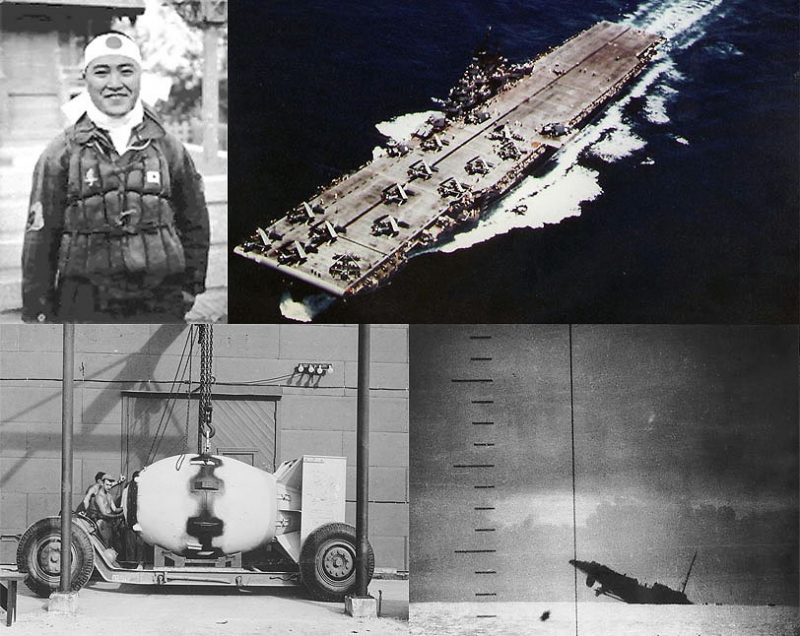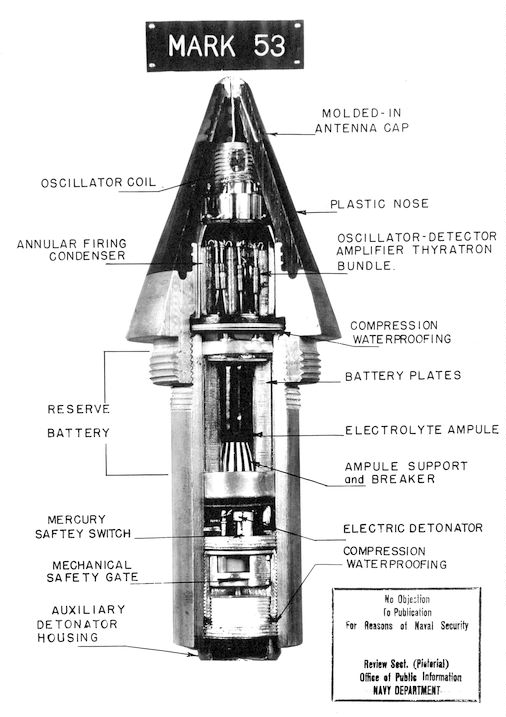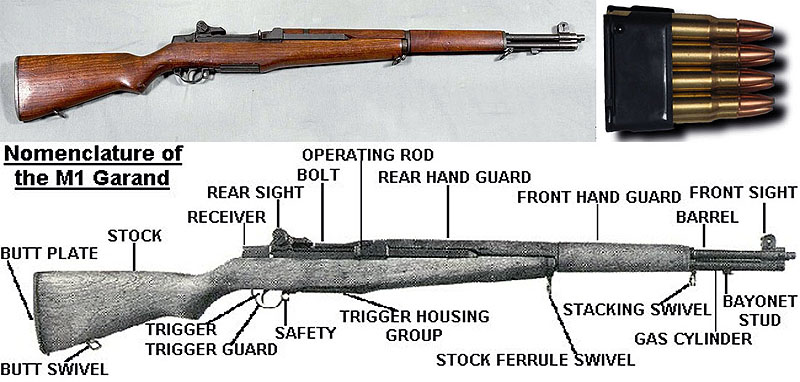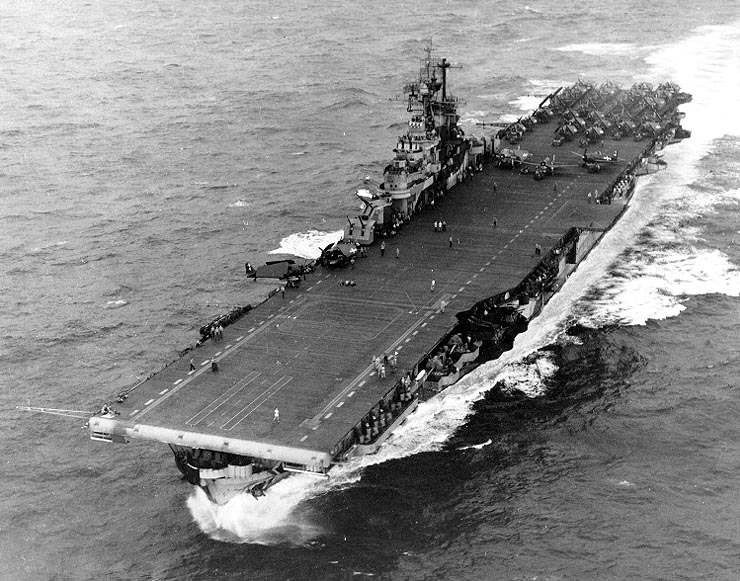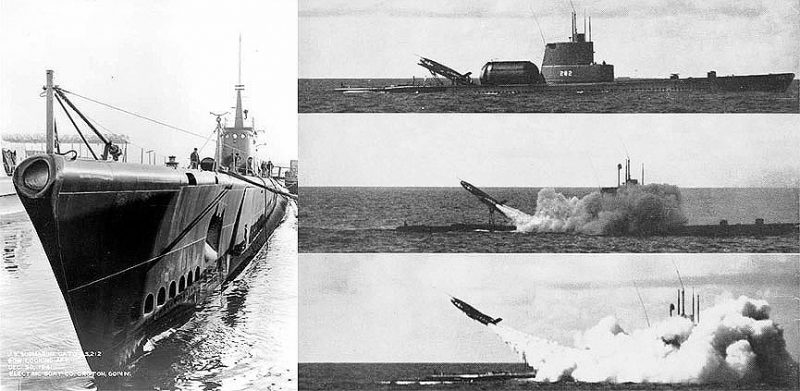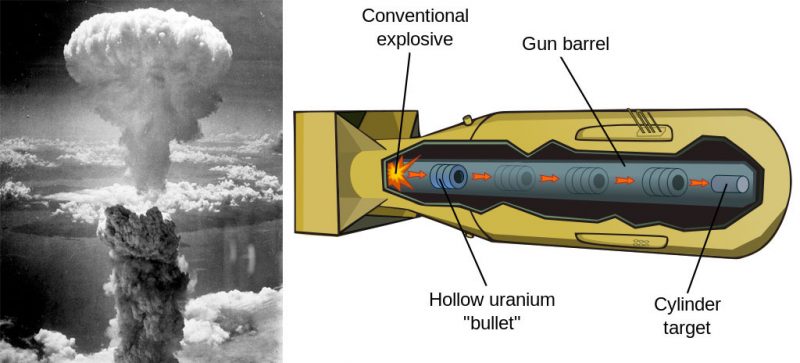Images Used (Clockwise from top left): (1) Japanese aircraft pilot Kiyoshi Ogawa who died at the age of 22 year old when his aircraft hit USS Bunker Hill on May 11, 1945, during a Kamikaze suicide mission. Proximity Fuzes were developed by US to prevent such attacks (2) USS Yorktown, the American Essex-class carrier at sea in 1943 (3) A Japanese Patrol boat sinking after being torpedoed, a US submarine periscope photo during WWII (4) Atomic Bomb Fat Man being transported during WWII
Weapon technology advanced rapidly during WWII. Many innovative weapons were designed in response to needs of different combatants. United States has been in possession of three types of weapons of mass destruction since the WWII, which are- nuclear weapons, biological weapons and chemical weapons. Both quality and quantity ensured the US victory in WWII. Huge amounts of American war equipment and weapons not only outmatched and overwhelmed the weapons of the Axis forces, but also helped the lend-lease allies such as- Britain and Russia to dominate over the Axis forces.
Not all US weapons were outstanding. M-4 Sherman tanks were produced in huge numbers but were average. The early US fighters P-40 and P-39 were nothing to boast about. Until 1943, the US submarine torpedoes often showed the flaws of not exploding. However, by proper utilizing its massive technological and industrial base, United States was able to produce some exceptional weapons during WWII. The only country to have used nuclear weapons in the world in a war is United States and world saw atomic bombings of Japanese cities Hiroshima and Nagasaki in WWII. Online edition of American bi-monthly international affairs magazine The National Interest, reported on 5 such deadliest American weapons from WWII.
(5) VT Proximity Fuzes:
Fuze or fuse in military munitions is a device for initiating function. In case of a torpedo, a fuze would act as an exploder. It is an intricate combination of mechanical and electrical components used as ignition device. Proximity Fuze is a special type of fuze that can detonate an explosive gadget automatically when the distance between the target and the explosive device becomes equal to or smaller than a predetermined value. Sensors in Proximity Fuze can sense the distances between the explosive device and the target.
Though many would not put Proximity Fuzes in the category of weapons, the German infantrymen and the Japanese pilots discovered it to be extremely deadly weapon. During the WWII era, most anti-aircraft guns lacked sophisticated fire control CPUs, computers or radar. The calculations required to hit moving targets were so complex that during WWII, on an average, tens of thousands of rounds of ammunitions were required to be fired at airplanes flying two to five miles high to score a hit.
American battleships suffered from this acute problem of not being able to hit moving targets precisely. The Japanese suicide aircraft’s Kamikaze attack made things worse for the Americans. The Kamikaze attacks were actually pilot guided suicidal explosive missile attacks. 3,860 kamikaze pilots were killed during WWII and 19% of those Kamikaze attacks were able to hit an Allied ship. The suicide aircraft had to be shot down quickly.
US Navy then developed the Variable Time (VT) Proximity Fuzes that helped the U.S. battleships survive the severe threat of Kamikaze attacks. When the British researchers were not being able to fully develop the VT Proximity Fuzes, American geophysicist Merle Tuve completed developing it at the Applied Physics Lab of The Johns Hopkins University. The VT Proximity Fuzes also helped the US army in the major offensive against the Germans during the Battle of Bulge that took place in Belgium, Germany and Luxembourg. The tiny Fuze was placed in the nose of each anti-aircraft shell. And instead of exploding while striking the aircraft, the shell could be set to explode near the target upon Doppler radar in the VT Proximity Fuze sensing that the target was close enough. The resulting cloud of high speed shrapnel from the exploded shell could effectively hit aircraft or infantry.
Image Used: A proximity fuse MK53 during the 1950s which had been removed from a shell.
(4) M-1 Garand Rifle:
M1 Garand rifle is a 0.30 caliber semi-automatic US rifle designed in 1928 by Canadian-American firearms designer John Garand. It was in service as the standard US service rifle from 1936 to 1957. Thousands of these rifles were also lent or supplied to the allies of United States as foreign aid. M1 was still in use in large numbers until 1976 and today it is mainly used for drill purposes. From 1936 to 1957 and in the 1980s total 6.25 million M1 Garand rifles were produced and per unit cost was $85 during WWII.
At the beginning of the WWII, armies used bolt action rifles. In a bolt action rifle, weapon’s bolt is operated manually with a small handle. And spent cartridge case is withdrawn and ejected manually using the bolt action. Though bolt action rifles could allow powerful cartridge chambering, it has lower practical rate of fire than the semi-automatic weapons. The M-1 enabled US infantry to have a distinct superiority in firefights against the Axis forces as the standard rifles of Axis armies were the slow firing bolt action rifles.
M1 is a gas-operated, air-cooled, clip-fed, shoulder-fired, semi automatic rifle. Which means that the expanding gas of the previously fired round gives power to cock the rifle and chamber the succeeding round; air cools the barrel; that it is loaded by inserting an en bloc ammunition clip. Semi automatic means the rifle fires one round each time the trigger is pulled. M1 is chambered for .30-06 Springfield rifle cartridges (7.62x63mm) or 7.62×51mm NATO cartridges.
Germans had the superior and deadly machine guns like MG-42. Therefore the American infantry was lucky to have M-1, a reliable weapon that gave them a fighting chance against their well-equipped enemies.
Images Used (Clockwise from top left): (1) An M1 Garand rifle put on display at the Swedish Army Museum, Stockholm, Sweden (2) An en bloc ammunition clip of M1 rifle loaded with eight .30 caliber rounds (3) Important parts of an M1 Garand rifle labeled
(3) Essex-class aircraft carrier:
The pacific theatre of WWII was basically a war of aircraft carriers- the mobile, floating airstrips that dispelled the battleships from attacking supply and troop convoy. The American Essex class carriers had the most numerous types of capital ships with 24 vessels completed between 1941 and 1950 out of total 32 planned.
The Essex-class carriers had a displacement of 36,960 tons, length of 888 ft (270.7 m), beam of 147 ft 6 in (45.0m), draft of 27 ft 6in (8.4m) and a speed of 32.7 knots (60.6kmph). In the later stages of the WWII, these carriers were the backbone of US carrier fleet. Each carried about a hundred fighter aircraft, torpedo bombers and dive-bombers. These carriers were also equipped with fighter direction facilities with sophisticated radar and attacks launched from these devastated the Japanese Navy in the battles such as Battle of Leyte Gulf and Battle of the Philippine Sea. No Essex class carriers were lost in action and these were the backbone of the American Navy’s combat strength from the mid 1943 to the 1970s when they took part in WWII, the Korean War and in the Vietnam War.
Image Used: USS Intrepid, another American Essex-class Navy aircraft carrier in the Philippine Sea in November 1944
(2) Gato-class submarine:
US Navy aircraft carriers and battleships were the leading elements that ensured a win over Japanese war elements; however, US submarines also had a significant role by sinking 55% of Japanese naval tonnage. The Gato class subs were launched between 1941 and 1943 and 77 were completed. 20 of these were lost in action and 57 more retired with 6 subs preserved.
Gato class submarine had a displacement of 2,424 tons while submerged, length of 311 ft, beam or width of 27 ft 3in, draft of 17 ft. Four diesel engines with a total 4,000 kW or 5,400 shp propelled it at 21 knots while surfaced and two 2,040 kW or 2,740 shp electric motors propelled the sub at 9 knots while submerged. She could carry 60 naval officers and men.
By 1945, the American submarines severely destroyed the Japanese merchant fleet which had been importing vital raw materials and food for Japan. If the German U-boats and American submarines were compared then U-boats would be judged as the most deadly subs. Because the U-boats had to face sophisticated Allied weapons and intense Allied defenses that killed over 60% of U-boat crews while the US subs faced Japanese anti submarine capabilities which were not up to the mark at all. Nonetheless, Gato class submarine was a terrific naval weapon.
Images Used (From Left): (1) USS Gato, Gato-class submarine in December 1941 (2) USS Tunny (SSG-282), a US Gato-class submarine, launching a missile in the 1950s.
(1) Atomic Bomb:
Nuclear weapon is a weapon of mass destruction which derives its cataclysmic force form nuclear reaction, either nuclear fission or a combination of nuclear fusion and fission. Vast quantity of energy is released from a small amount of matter in a nuclear reaction. In a nuclear power plant the chain nuclear reaction is controlled, but in a nuclear weapon the nuclear chain reaction rate increases exponentially in an uncontrollable manner. A thermonuclear weapon (hydrogen bomb) weighing 1,100 kg or 2,400 pound can produce an explosion similar to 1.2 million tons of TNT. Thus a small nuclear bomb can decimate an entire city. Beside blast and fire, deadly nuclear radiation is the long lasting impact that can cause cancers among inhabitants of the affected city even after decades.
Nuclear weapons were developed for the first time by United States, not to mention they were the first and only country to have used them in a war. Out of the fear that the Germans were developing nuclear weapons, American President Roosevelt ordered to develop nuclear weapons and Manhattan Project began in 1939. The project name was opted in 1942.
World War II ended in Europe when Nazi Germany surrendered on May 8, 1945. Imperial Japan was refusing to accept the demand of the Allies for unconditional surrender and the Pacific theater of the war dragged on. Together with China and UK, United States called for unconditional surrender of the Japanese forces and threatened to cause an ‘utter destruction’ in case of a refusal from Japan. Manhattan Project had already detonated an atomic weapon successfully in New Mexico by August 1945. To end the war, a uranium gun type atomic bomb, code named ‘Little Boy’ was dropped on Japanese city Hiroshima on August 6, 1945 from a Boeing B-29 Superfortress heavy bomber. Then on August 9, 1945, a plutonium implosion type atomic bomb, code named ‘Fat Man’ was dropped on Japanese city Nagasaki from another B-29 Superfortress. Soviet Union declared war on Japan on the day of Nagasaki bombing and Japan announced to surrender on August 15, 1945.
Finally Japan signed the instrument of surrender on September 2, 1945 and ended fighting against Red Army in the Japanese puppet states. Due to the Atomic bombings, 39,000 to 80,000 people were killed in Nagasaki and 90,000 to 166,000 in Hiroshima. In the case of each bombing, half of the total deaths occurred on the first day. Most of the dead were civilians, though there was an extensive military garrison in Hiroshima. The necessity of dropping atomic bombs in the two Japanese cities is a heavily debated topic till today. Nevertheless, despite witnessing such devastations of the Atomic bombs, the World powers are still in possession of over 17,000 nuclear war heads and over 2,000 detonations had been carried out for demonstrations and test purposes since WWII.
Images Used (From Left): (1) The mushroom cloud of the ‘Fat Man’ atomic bomb during the bombing of Nagasaki, Japan on August 9, 1945 (2) The internal diagram of the Atomic Bomb ‘Little Boy’ showing how uranium bullet started a nuclear explosion
Video Used: 8 minutes long video clip taken from a documentary on WWII showing real and reconstructed scenes of the Hiroshima bombing.
